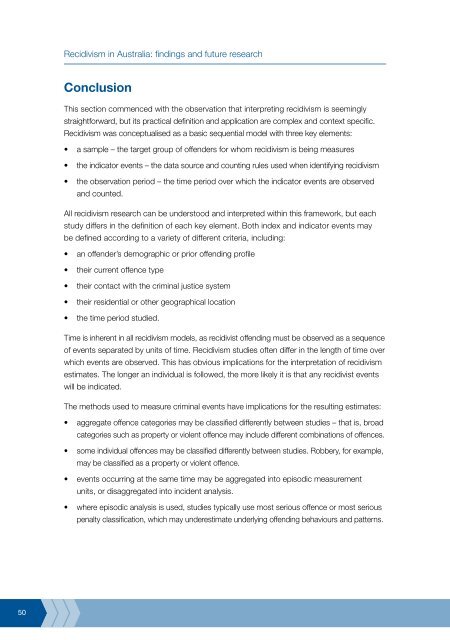Recidivism in Australia : findings and future research - Australian ...
Recidivism in Australia : findings and future research - Australian ...
Recidivism in Australia : findings and future research - Australian ...
Create successful ePaper yourself
Turn your PDF publications into a flip-book with our unique Google optimized e-Paper software.
50<br />
<strong>Recidivism</strong> <strong>in</strong> <strong>Australia</strong>: f<strong>in</strong>d<strong>in</strong>gs <strong>and</strong> <strong>future</strong> <strong>research</strong><br />
Conclusion<br />
This section commenced with the observation that <strong>in</strong>terpret<strong>in</strong>g recidivism is seem<strong>in</strong>gly<br />
straightforward, but its practical def<strong>in</strong>ition <strong>and</strong> application are complex <strong>and</strong> context specific.<br />
<strong>Recidivism</strong> was conceptualised as a basic sequential model with three key elements:<br />
•<br />
•<br />
•<br />
a sample – the target group of offenders for whom recidivism is be<strong>in</strong>g measures<br />
the <strong>in</strong>dicator events – the data source <strong>and</strong> count<strong>in</strong>g rules used when identify<strong>in</strong>g recidivism<br />
the observation period – the time period over which the <strong>in</strong>dicator events are observed<br />
<strong>and</strong> counted.<br />
All recidivism <strong>research</strong> can be understood <strong>and</strong> <strong>in</strong>terpreted with<strong>in</strong> this framework, but each<br />
study differs <strong>in</strong> the def<strong>in</strong>ition of each key element. Both <strong>in</strong>dex <strong>and</strong> <strong>in</strong>dicator events may<br />
be def<strong>in</strong>ed accord<strong>in</strong>g to a variety of different criteria, <strong>in</strong>clud<strong>in</strong>g:<br />
•<br />
•<br />
•<br />
•<br />
•<br />
an offender’s demographic or prior offend<strong>in</strong>g profile<br />
their current offence type<br />
their contact with the crim<strong>in</strong>al justice system<br />
their residential or other geographical location<br />
the time period studied.<br />
Time is <strong>in</strong>herent <strong>in</strong> all recidivism models, as recidivist offend<strong>in</strong>g must be observed as a sequence<br />
of events separated by units of time. <strong>Recidivism</strong> studies often differ <strong>in</strong> the length of time over<br />
which events are observed. This has obvious implications for the <strong>in</strong>terpretation of recidivism<br />
estimates. The longer an <strong>in</strong>dividual is followed, the more likely it is that any recidivist events<br />
will be <strong>in</strong>dicated.<br />
The methods used to measure crim<strong>in</strong>al events have implications for the result<strong>in</strong>g estimates:<br />
• aggregate offence categories may be classified differently between studies – that is, broad<br />
categories such as property or violent offence may <strong>in</strong>clude different comb<strong>in</strong>ations of offences.<br />
•<br />
•<br />
•<br />
some <strong>in</strong>dividual offences may be classified differently between studies. Robbery, for example,<br />
may be classified as a property or violent offence.<br />
events occurr<strong>in</strong>g at the same time may be aggregated <strong>in</strong>to episodic measurement<br />
units, or disaggregated <strong>in</strong>to <strong>in</strong>cident analysis.<br />
where episodic analysis is used, studies typically use most serious offence or most serious<br />
penalty classification, which may underestimate underly<strong>in</strong>g offend<strong>in</strong>g behaviours <strong>and</strong> patterns.















